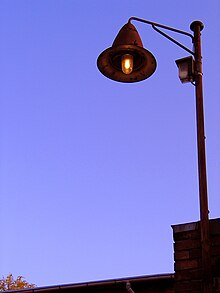Fuchswerke

The Fuchswerke in Hanover are located on a former factory site in the Hanover district of Badenstedt at the address Empelder Straße 96 . After the renovation of the factory buildings, some of which date from the late 19th century, and an award-winning renovation of the historic complex, workshops, offices, shops, studios and apartments can be found here, as well as one of the last surviving former slave laborers barracks in the Lower Saxony state capital.
history
On the site of what would later become the Fuchswerke in Badenstedt, the entrepreneur Louis Tidow built a factory for the production of fire brigade syringes in the late 19th century of the German Empire in 1898 .
After the First World War , the Fuchs brothers, who had previously founded the “ADMI-Werk” in 1907, acquired the former Tidow factory in Badenstedt in 1919, which they soon expanded to become their main factory after the Berlin factory was no longer sufficient for production . In Badenstedt the company ADMI-Werke Brüder Fuchs was able to work on an area of almost 10,000 m² and building areas of around 6,000 m² with at times more than 700 employees. As the largest company in what would later become the Hanover district, it was here that medical-technical equipment such as hospital beds or operating tables were produced and exported worldwide.
While the company's furnishings, some of which were constructed in the imperial era, are still in operation in the museum today, such as an offset punch, the original and functional elevators at ADMI-Werke date from 1936 and 1952.
During the Second World War in 1941, a barrack for prisoners of war was set up during the Nazi era . At the same place in 1943 a “barracks for foreign workers” manufactured by the company Böker & Söhne , measuring 10 × 21 m, was built. In the post-war period , the barrack was still used as a “ foreign workers ' home” in the 1960s .
After the production of the ADMI works at the Badenstedt location was discontinued in 1993, Rolf Häcker acquired the industrial wasteland in 1994 and soon afterwards began extensive renovations while largely preserving the historical building fabric and structure. While the new owner announced the installation of a commemorative plaque on the former prisoner-of-war barracks, he wanted to enable “living and working together” on the site with its large open space.
Green spaces

Despite a rather positive report on possible pollutants on the site, in 1995 Häcker had the soil of the open area dug out and the topsoil filled with around 40 articulated trucks. The area was then planted with trees and bushes, especially around the old fire station, creating a biotope for birds and bats. While specially created Benjes hedges serve hedgehogs and other small animals, the green areas have been planted with fragrant, partly old flower cultivars, herbs and medicinal plants, which are pollinated by the bees of the beehives set up on the site.
Only a few weeks after the world exhibition Expo 2000 , the Buddha statue of the Indonesian pavilion was erected on the site in November of that year to underline the transformation of the former factory area into an "oasis for people and animals". In 2001, the site was finally awarded 1st prize in the residential environment competition of the state capital Hanover.
Other uses
For a time, the artist Nigel Packham had his studio on the premises at Empelder Straße 96.
Web links
Individual evidence
- ↑ a b c d e f g h Rolf Häcker: formerly Fuchswerke / factory in transition , historical overview and description of the current situation on the fuchswerke.de page [ undated ], last accessed on April 5, 2019
- ^ Nigel's Best leaflet on the E-Damm 13 gallery [undated], last accessed on April 5, 2019
Coordinates: 52 ° 21 ′ 3.2 ″ N , 9 ° 40 ′ 9 ″ E

